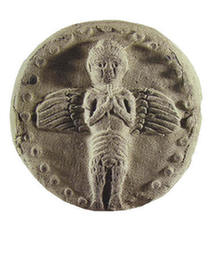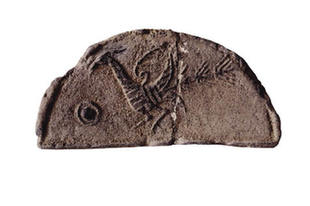|
Tile Ends
|

|
| A tile end with a winged human figure, dating from the Tang Dynasty. |
Tile ends, round or half-moon-shaped, are a constituent of ancient
Chinese architecture. They help protect wooden eaves from water damage while adding architectural grace to buildings. Today they also help archeologists determine the age of archeological excavations.
Tile ends originated in the Western Zhou Dynasty (11th century-771 B.C.), and reached their heyday in the Han Dynasty, when potters often engraved tile ends with blessings rendered in lesser seal characters as decorative patterns. With the help of unearthed tile ends marked with "Long-life Weiyang" or "Long-Joy Weiyang," archeologists easily located the site of the Han Dynasty imperial palace in Xi'an, which was also the capital of the earlier Qin, and the later Sui and Tang, dynasties.
 |
|
A half-circle tile end engraved with a phoenix,from the State of Qi, during the Warring States Period. |
Tile ends of different periods bear traits of their time. A king-sized tile end, more than 40 cm in height, reflects the audacity and ambition of the mighty Qin Dynasty. The Tang Dynasty has left us a tile end with a half naked winged human figure, with hands closed in front of the figure's chest. Such an image is rarely seen in works of the same period. Researchers believe the winged figure is Western Asian in appearance, and its discovery has further verified the prosperity and flourishing cultural exchanges of the Tang Dynasty. |
